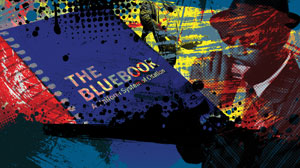The Bluebook's 20th edition prompts many musings from Bryan Garner

Illustration by Brenan Sharp
At one point he wrote an exasperated note about the many strange abbreviations that were showing up in his page proofs: “Cent.,” “Dist.,” “Int’l,” “Mfg.,” “Servs.,” “Techs.” and so on. What were those little monstrosities? And what did “Bhd.” and “Ref.” stand for?
I explained that because the book would be published in both the United States and the United Kingdom, I was following the well-established conventions of Table T6 in The Bluebook: A Uniform System of Citation—then in its 18th edition. Megarry wanted me to spell out everything except “Co.” and “Ltd.” In the end, though, he relented—while reserving the right to grumble.
England, you see, has never had a uniform system of citation with anything like the universal acceptance that The Bluebook has enjoyed. To the American eye, British cases are cited strangely, with the year of the decision before the volume and page numbers. Words aren’t abbreviated in case names, and the citation style for books and articles more closely follows the style of the humanities, with “p. 6” or “at 6” at the end. For example:
• Medical Defence Union Ltd. v. Department of Trade, [1980] Ch. 82, at 95.
• Stepney Borough Council v. Joffe, [1949] 1 K.B. 599, at 603.
• Sir John Hollams, Jottings of an Old Solicitor (1906), pp. 128–29.
Now that The Bluebook has been increasingly internationalized over the past few editions, the British methods for citing cases have been incorporated—with minor adaptations—into its canonical rules. (See [this is proper Bluebook form:] The Bluebook: A Uniform System of Citation 414 tbl. T2 (19th ed. 2010).)
CURIOUSER AND CURIOUSER
The occasion for these musings is the publication of the 20th edition of The Bluebook, which appeared in May. It is a curious book with a curious history. Though much reviled—perhaps most famously by Judge Richard A. Posner in his 1986 essay “Goodbye to The Bluebook“—it has attracted fanatical followers who memorize its arcana. They’re devoted to its every diktat. They even know which commas and periods get italicized and which ones don’t.
From an author’s standpoint, the most irksome thing about a new Bluebook is the nettlesome changes that take place. When my first book (A Dictionary of Modern Legal Usage) was published in 1987, for example, The Bluebook specified that no first names should be given for law review authors. I followed that prescription rigorously. That was just the way law journals were cited, and to a young lawyer it seemed like an immutable convention.
But by the time the second edition of Modern Legal Usage appeared in 1995, the rule had changed: First names and middle initials were to be included. This rule shift meant hunting down dozens of first names and middle initials from the first edition. Great fun.
By the time the third edition of 2011 appeared, The Bluebook had been modified in other little ways. For example, the abbreviations list had just about doubled. My research assistants, all then-current law students, gawked at this professor’s now-incorrect citations. They didn’t realize that I’d simply been following an earlier edition of The Bluebook.
What I’ve come to realize is that when it comes to The Bluebook, small changes are made for the sake of making small changes. New law students want their predecessors’ work to look obsolete. It’s the theory first elaborated by the social philosopher Thorstein Veblen: planned obsolescence. Veblen postulated that companies deliberately produce consumer goods that will become outdated after limited use so that consumers will have to buy new items more often.
You see the principle at work with smartphone chargers (your old ones won’t work on your new gear), iPod connections (ditto), lightbulbs and even coursebooks. Legal publishers like frequent editions so as to avoid the forgone profits represented by a secondhand market.
And so it is with The Bluebook. Things shift from edition to edition—every five years or so—in response to nothing but the itch of a new crop of law students to leave their mark on their venerated citation guide.
You can well understand why many law professors freeze their style in whatever was current when they were law students. The redoubtable Charles Alan Wright, for example, used the 1949 version of The Bluebook throughout his career. He cited the 2nd U.S. Circuit Court of Appeals at New York City as “CA2” (as prescribed by early editions of The Bluebook), not as “2d Cir.” That makes sense: Federal Practice and Procedure (known informally as “Wright & Miller”) is a 100-plus-volume set of books (counting pamphlets) with varying dates of publication—often more than five years apart. If each volume followed the then-current Bluebook, a great deal of citational variation would appear within the same set of books.
Some would be unbothered by these inconsistencies; others would be driven to distraction by them. The divide seems to be traceable to a personality trait: those who insist on orderliness and consistency versus those who couldn’t care less.
EDITIONS OF BLUE
One of my research assistants recently corrected proofs of a book I’m working on by abbreviating the first word in a litigant’s name: Se. for Southeastern. I responded by patiently encouraging her to go look at The Bluebook: “First of all, you don’t abbreviate the first word in a corporate litigant’s name—ever. Second, ‘Southeastern’ should be ‘S.E.’ or ‘SE,’ but certainly not ‘Se.’ “
Within minutes, she produced the 19th edition of The Bluebook, which said that first words in litigants’ names are now abbreviated, and the abbreviation for “Southeastern” is indeed “Se.” It seems I was remembering a rule from the 15th edition of 1991, and I hadn’t realized the rule had changed. Somebody had moved my cheese—and in any event I immediately concluded that it had gone rancid.
It made me think of Megarry. What would he make of a case styled “Alt. Coal. Constr. P’ship v. Ne. S.S. Twp. Cmty. Bhd.”? That’s what the new Bluebook calls for. Aw, nuts.
Once again, the table prescribing all these abbreviations is the famous T6. Ask a group of lawyers what T6 is. A few will feel their pulses quicken as they explain that it’s the list of words we’re obligated to abbreviate in case names (except when the case name is presented as part of a sentence in text, as opposed to a mere “citation sentence”).
There are rules, you see, exceptions to rules and exceptions to exceptions. These are all elaborated in the 560 pages of the 20th edition. By contrast, the earliest edition of The Bluebook in my possession is the 10th edition of 1958. It weighs in at 124 pages.
This is a big year in citational circles. The Association of Legal Writing Directors has also published the fifth edition of its ALWD Citation Manual, which in legal writing circles is believed to have the avowed purpose of making its conventions perfectly consistent with The Bluebook.
In that endeavor it doesn’t quite succeed, for it has out-abbreviated Table T6. ALWD lists 191 abbreviations for case names against T6’s 183. Among these are “Aband.” (for Abandoned), “Aff.” (not Affiliated, mind you, but Affair(s)) and “Elec.” (which is to do dual service for Elections and Electric plus its cognates—whereas in The Bluebook it’s just for the latter).
But in most instances the idea behind the new ALWD has been to prevent differences between it and The Bluebook. A few vociferous citation geeks had boycotted earlier editions of ALWD because it endorsed “Natl.” and “Intl.” instead of “Nat’l” and “Int’l” (no periods, please note, because the terminal characters are the last in the actual words—a tacit Bluebook rule). Now ALWD is on board with “Nat’l” and “Int’l.”
It’s astounding just how emotionally fixated some people get about such things. Why does ALWD generally want to have its citations synonymous with those of The Bluebook? It appears that The Bluebook is all but impossible to keep up with—and that it will never be “Aband.”
This article originally appeared in the August 2015 issue of the ABA Journal with this headline: “Singing The Bluebook Blues: The citation casebook’s 20th edition prompts many musings.”
Bryan A. Garner (@BryanAGarner) is the president of LawProse Inc. and a law professor at Southern Methodist University. He is the author of The Redbook: A Manual on Legal Style and Legal Writing in Plain English.



